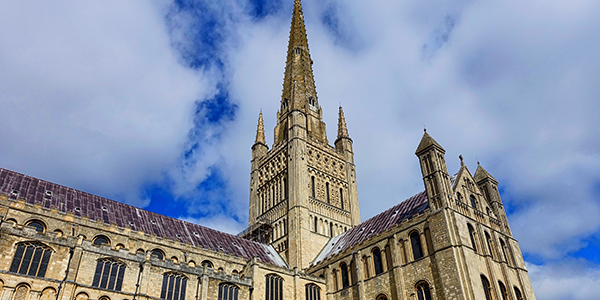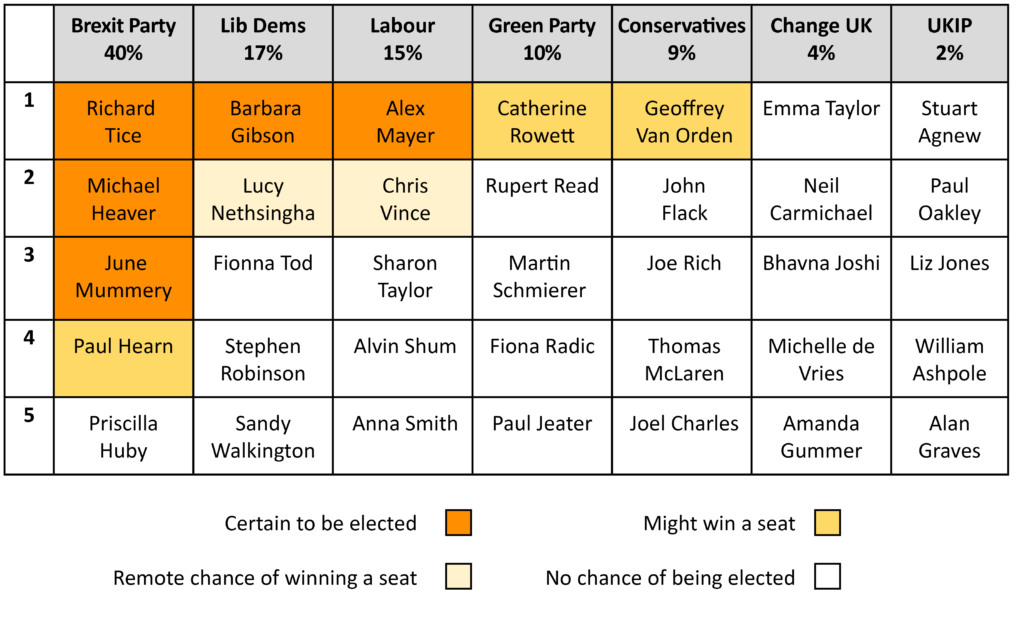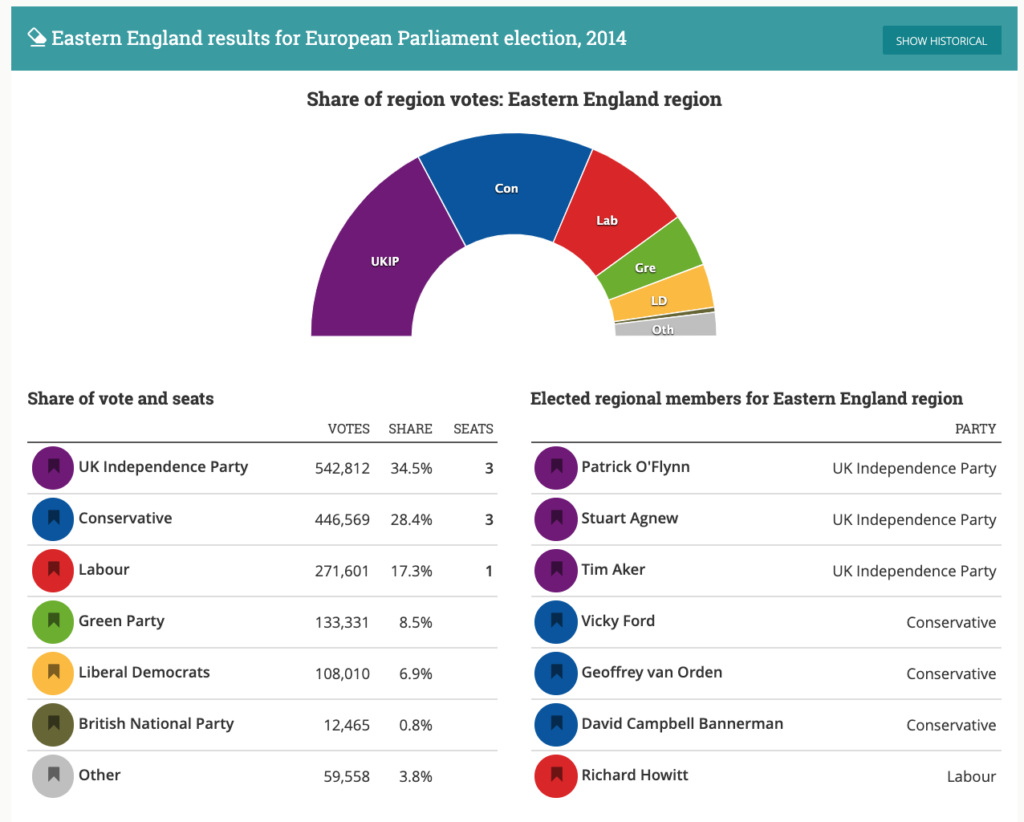European elections 2019: what will happen in the East of England region?
Traditionally this is a Conservative region at Westminster elections. Yet the East of England is strongly Eurosceptic and UKIP came top here in the last European Parliament elections in 2014, although the Tories hung on (just) to three seats. The Brexit Party now look certain to take over the UKIP vote and comfortably come first: on current polls they are guaranteed three of the region’s seven seats, and possibly one more. The latest polling indicates that Labour and the Liberal Democrats look assured of a single seat each. So the main uncertainty hangs on just how dominant the Brexit Party vote will be, whether the Tories’ slump means that they lose all of their seats here, and whether the Greens can pick up a seat. With voters able to cast only a single vote for a party list, the Democratic Audit team reviews likely outcomes for the parties and the main potentially electable candidates.

Norwich cathedral. Picture: MemoryCatcher / 3041 images
The East of England region juts into the North Sea and covers East Anglia down to the northern fringes of London. People here voted 56.5% to 43.5% for Leave in the Brexit referendum. Yet the area also includes some anti-Brexit cities such as Norwich and Cambridge. Last time UKIP won 35% of the vote and gained three MEPs (two of whom subsequently defected to other parties). Nigel Farage’s new party, the Brexit Party, has now mopped up virtually all this support and squeezed the Tories also. Figure 1 below shows the latest YouGov poll giving Farage’s party 40%, which is above their national average. Over time their surge in support also seems to be firming up. On these sorts of numbers, the Brexit Party should comfortably secure three MEPs, including their party chairman Richard Tice, who tops their list. They could well win four if the polls are right.
The same polling puts Liberal Democrats second on 17%. This guarantees a seat for the top Lib Dem candidate, but there has not been much movement towards the party in this region, unlike some other areas. There is a small chance the party just might win a second seat, if they can reverse this regionally stagnant picture in the campaign’s closing days. Labour are just behind on 15%, down slightly from 17% in 2014. Their current MEP Alex Mayer heads their list and is sure to retain her seat on this basis. However, a recent drop in their polling numbers looks likely to cost the party any chance of a second seat here.
Another strong pro-Remain party, the Greens, are currently polling fourth on 10%, which gives them a good chance of winning a seat. The new party, Change UK, are substantially behind this level on just 4%, perhaps suggesting that strong pro-Remain voters are moving either to the Greens or the Lib Dems.
Currently polling fifth are the Conservatives, with just 9% (down from 28% in 2014). They still have a chance to retain one of their three seats here, if their support is resilient on election day itself. But current polls give them no guarantee of even a single seat. The second candidate on their list, the sitting MEP John Flack, looks certain to lose. Finally, UKIP are polling at 3% and have no chance of winning anything, a huge fall from last time around.
All the parties have cluttered up the ballot paper with a full slate of seven candidates each, even though the lower ranked ones cannot possibly win a seat under proportional representation. Accordingly we show only a few of them (in Figure 1), and not the no-hope candidate names listed lower on each party’s list. (For a full candidate list of all parties and independents see here.) Voters can only vote for one party list, by marking a single X on the ballot paper, and cannot choose specific candidates. In making up their minds which party list to support, voters need only pay attention to the ten candidates in the shaded boxes here.
Figure 1: Main party candidates in the East of England region (with YouGov poll data, 8–17 May 2019) and possible winners (seven seats)

YouGov poll, 8–17 May, weighted by likelihood to vote, excluding those who would not vote, don’t know or refused
To find details of all the local candidates, and to locate your polling station, visit our Democratic Dashboard site and enter your postcode. The site also has full details of other recent elections in your local area.
Below we list a summary of any candidate in Figure 1 with some chance of being elected, and point you to their social media sites, which can show something of what each candidate is like as a person. At the bottom of this article we also show the full 2014 results for the East of England.
Which candidates can win seats in the East of England in 2019?
THE BREXIT PARTY stand to be the big winners in the East of England, with their top three candidates, Richard Tice, Michael Heaver and June Mummery, all seemingly certain to win seats. There’s a good chance that they will be joined by Paul Hearn, if the party can maintain its recent surge.
- Richard Tice (Twitter: @TiceRichard) is Chair of the Brexit Party, and a property entrepreneur. Tice was co-founder of Leave.EU, the unofficial Leave campaign during the referendum, with Arron Banks (who described him as ‘the acceptable face of Leave.eu’), and co-founder of ‘Leave means Leave’ after the referendum. Previously he was a member of the Conservative Party.
- Michael Heaver (Twitter: @Michael_Heaver) is a co-founder of Westmonster UK, a strongly pro-Brexit website, and former press officer to Nigel Farage.
- June Mummery (Twitter: @june_mummery) is a fisheries campaigner, and managing director of Lowestoft fish market auctioneers BFP Eastern. Mummery has long campaigned for Brexit.
- Paul Hearn voted Remain in 2016, but now wants to see Britain leave the EU. You can hear Hearn talk here.
LIBERAL DEMOCRATS do not currently have an MEP in the region, having lost Andrew Duff in the 2014 election. But they look certain to win one seat – if polls are correct. They might just conceivably get two, but only if strongly pro-Remain voters from other parties rally to their cause.
- Barbara Gibson (@Barb_G). Oklahoma-born Gibson is a county councillor, and also the Lib Dem prospective candidate for Welwyn Hatfield. You can read more about her here.
- Lucy Nethsingha (Twitter: @LNethsingha) is a former teacher, and also the Lib Dem leader on Cambridgeshire County Council and prospective candidate for the South East Cambridgeshire constituency. You can read more about her here.
LABOUR – On current polling, Labour look set to retain their one seat in the region, but no more.
- Alex Mayer (Twitter: @alexlmayer) is a sitting MEP. She stood in 2014 as Labour’s number 2, but was not elected then. She has been in the European Parliament only since 2016 when Labour’s 2014 winner Richard Howitt stood down during the course of the parliament. For her European Parliament voting record, see her Votewatch.eu profile here.
- Chris Vince (Twitter: @ChrisJVince) is a Harlow councillor and a secondary school maths teacher. He stood as the Labour candidate in Chelmsford in both 2015 and 2017.
GREEN PARTY have come up to fourth in this region in recent polls, and might just win a seat. They did well in local elections and have some heartland strength in the region’s Remain pockets like Norwich.
- Catherine Rowett (Twitter: @catherinerowett) is Professor of Philosophy at the University of East Anglia in Norwich.
CONSERVATIVES – Currently in fifth place here, the Conservatives could still retain one seat on current polling. But winning a second seat looks impossible, despite having an incumbent MEP as candidate.
- Geoffrey Van Orden (Facebook page) was first elected to the European Parliament in 1999 and is a former soldier. For his voting record, see Votewatch.eu here.
- John Flack (Twitter: @JohnFlackMEP) is an incumbent MEP but was actually only number 4 on the Tories’ 2014 candidate list. He entered the European Parliament only in 2017, when the former MEP Vicky Ford won a Westminster seat and so stood down. He campaigns on animal welfare issues. His Votewatch.eu profile and voting record is here.
CHANGE UK are not flourishing in this region and look unlikely to win any seat.
- Emma Taylor (Twitter: @etaylorengineer) is an engineer who has worked in rail, oil and gas/energy and space, industries. You can read her profile here
UKIP – As elsewhere, UKIP have been eclipsed by the Brexit Party, but they may hope to draw a little comfort from having an incumbent MEP topping their list.
- Stuart Agnew (Personal website) has been a UKIP MEP for the region since 2009, and is also a farmer. One of the handful of MEPs still in the party his voting record is on his votewatch.eu profile.
Figure 2: 2014 European Parliament election results for the East of England

Source: Democratic DashboardOrder and current status: 1. Patrick O’Flynn (elected UKIP, defected to the SDP); 2 Vicky Ford (Conservative, since replaced by John Flack), 3 Richard Howitt (Labour, since replaced by Alex Mayer); 4. Stuart Agnew (UKIP); 5. Geoffrey Van Orden (Conservative); 6 Tim Aker (elected UKIP, now Brexit Party); 7 David Campbell Bannerman (Conservative).
Read more about how the European Parliament elections work:





 Democratic Audit's core funding is provided by the Joseph Rowntree Charitable Trust. Additional funding is provided by the London School of Economics.
Democratic Audit's core funding is provided by the Joseph Rowntree Charitable Trust. Additional funding is provided by the London School of Economics.
A very useful summary with up-to-date stats and advice.
When I pointed out to The Guardian that in two places they had wildly got their figures wrong in one of these aspects (eg telling us that the South East region outside of London has 18 MEP seats!), they couldn’t even bother to correct them and the incorrect figures remain in place. And when I told ITN who made a similar mistake, the bored but harassed girl on the phone said “Oh well no-one is interested in all that kind of thing anyway”…she clearly wasn’t.
This is what we are faced with trying to get people interested in politics…